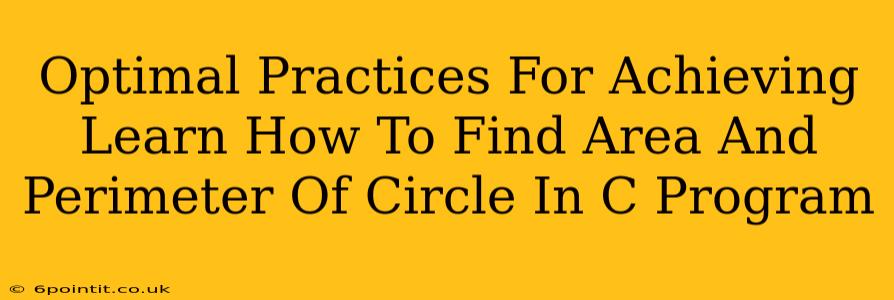Learning to calculate the area and perimeter (circumference) of a circle in a C program is a fundamental exercise in programming. This guide outlines optimal practices to ensure your code is efficient, readable, and robust. We'll cover everything from choosing the right data types to handling potential errors.
Understanding the Formulas
Before diving into the C code, let's refresh the formulas:
- Area of a Circle: π * r² (π multiplied by the radius squared)
- Circumference of a Circle: 2 * π * r (2 multiplied by π multiplied by the radius)
Where:
- r represents the radius of the circle.
- π (pi) is a mathematical constant, approximately 3.14159265359. For most practical purposes, using a more precise value improves accuracy.
C Program Implementation: Optimal Practices
Here's an example of a well-structured C program to calculate the area and circumference:
#include <stdio.h>
#include <math.h>
int main() {
// Declare variables. Using 'double' for better precision.
double radius, area, circumference;
const double PI = M_PI; // Use the predefined PI constant from math.h
// Get radius from user input. Error handling is crucial!
printf("Enter the radius of the circle: ");
if (scanf("%lf", &radius) != 1 || radius <= 0) {
printf("Invalid input. Radius must be a positive number.\n");
return 1; // Indicate an error
}
// Calculate area and circumference
area = PI * pow(radius, 2);
circumference = 2 * PI * radius;
// Display the results with clear formatting
printf("Area of the circle: %.2lf\n", area);
printf("Circumference of the circle: %.2lf\n", circumference);
return 0; // Indicate successful execution
}
Key Improvements & Explanations:
- Error Handling: The
scanffunction's return value is checked to ensure valid input. The program gracefully handles cases where the user enters non-numeric data or a non-positive radius. - Data Type: Using
doubleforradius,area, andcircumferenceensures sufficient precision for floating-point calculations. Avoid usingfloatunless memory is extremely constrained. math.hLibrary: Themath.hlibrary is included for thepow()function (to calculate the square) and theM_PIconstant, providing a more accurate value of π.- Clear Output: The
printfstatements provide user-friendly output with appropriate labels and formatting (.2lflimits the output to two decimal places). - Constants: Using
const double PI = M_PI;declaresPIas a constant, improving code readability and maintainability. It’s better than repeatedly typing 3.14159...
Further Enhancements and Considerations
- Function Decomposition: For larger projects, encapsulate the area and circumference calculations within separate functions to improve code organization and reusability. This enhances readability and simplifies testing.
- More Robust Input Validation: Implement more robust input validation to handle edge cases and potential errors more comprehensively. You could add loops that continue to prompt the user for input until valid data is entered.
- Unit Testing: Write unit tests to verify the correctness of your area and circumference calculations for various inputs, including boundary conditions (e.g., very large or very small radii).
By following these optimal practices, you can create a robust, efficient, and well-structured C program to calculate the area and perimeter of a circle. Remember that clean, well-documented code is essential for both readability and maintainability.

